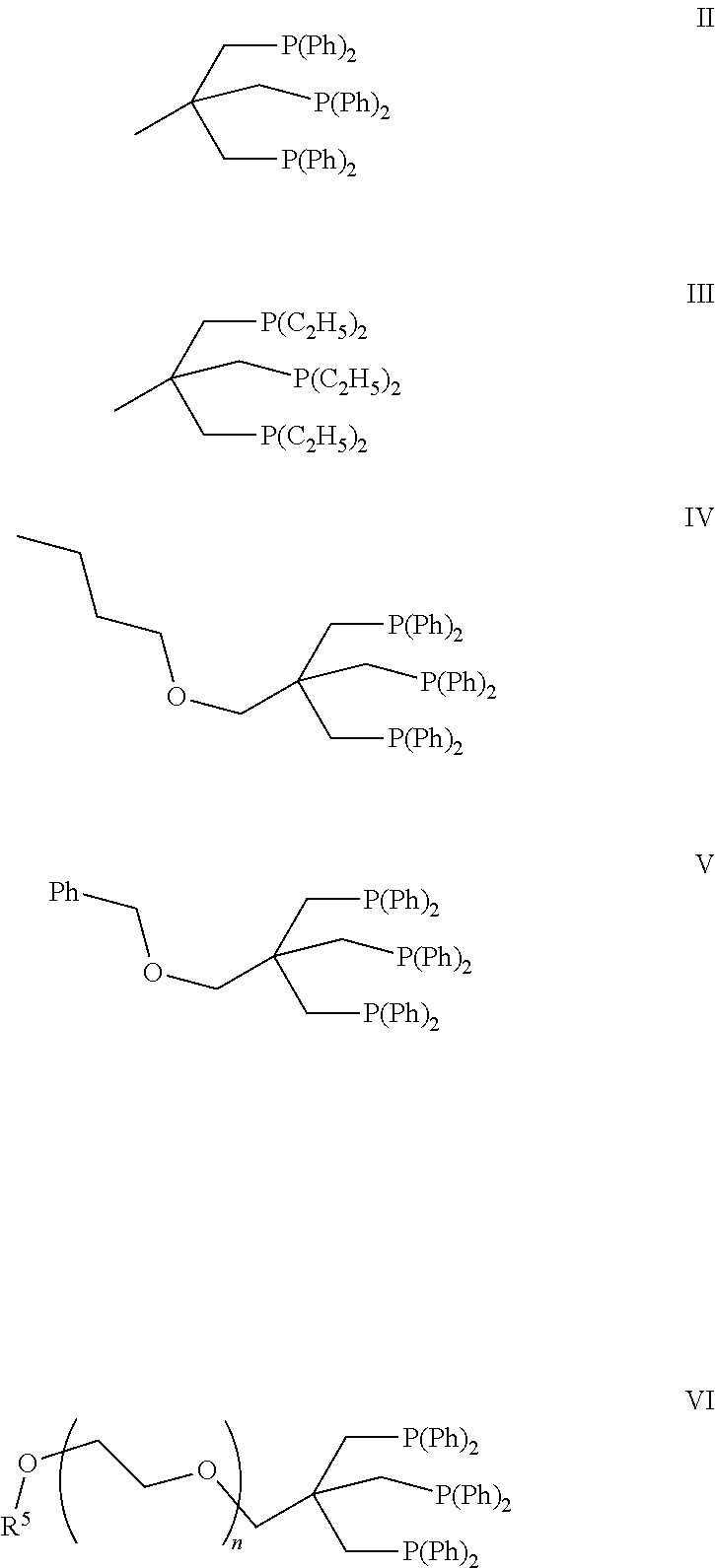Passivation of a homogeneous hydrogenation catalyst for the production of ethylene glycol
a hydrogenation catalyst and homogeneous technology, applied in the direction of organic compound/hydride/coordination complex catalyst, physical/chemical process catalyst, bulk chemical production, etc., can solve the problems of reducing the purity of eg overhead, yield loss in eg, variability in eg yield, etc., to reduce the amount of by-product formation, reduce the formation rate, and minimize the effect of formation
- Summary
- Abstract
- Description
- Claims
- Application Information
AI Technical Summary
Benefits of technology
Problems solved by technology
Method used
Image
Examples
example 1
Heating of Synthetic Product Feed A in the Presence of a Ruthenium Precatalyst Under a 70 Bara Carbon Monoxide Atmosphere
[0083]A 100 mL autoclave was charged with a solution of (Triphos)Ru(OAc)2 (0.0523 g) in 80.28 g of synthetic product feed A. A sample was then taken and analyzed by GC. The autoclave was then sealed, flushed three times with 15 bara nitrogen, then three times with 21 bara carbon monoxide. Stirring (1000 rpm) was then commenced and the reactor pressurized with 34 bara CO, heated to 190° C. then pressurized up to 70 bara with CO. The reactor contents were sampled at various intervals after the autoclave temperature reached 190° C. The pressure of the autoclave was maintained at 70 bara throughout the run. After eight hours at 190° C., the reactor was cooled to room temperature and depressurized. The reactor samples were analyzed by GC and the mole percent byproduct composition of the final product summarized in Table 1. This example demonstrates that essentially no ...
example 2
Heating of Synthetic Product Feed A in the Presence of a Ruthenium Precatalyst Under a 11 Bara Carbon Monoxide Atmosphere
[0084]A 100 mL autoclave was charged with a solution of (Triphos)Ru(OAc)2 (0.0503 g) in 80.08 g of synthetic product feed A. A sample was then taken and analyzed by GC. The autoclave was then sealed, flushed three times with 11 bara nitrogen, then three times with 11 bara carbon monoxide. Stirring (1000 rpm) was then commenced and the reactor pressurized with 11 bara CO and then heated to 190° C. The reactor contents were sampled at various intervals after the autoclave temperature reached 190° C. The pressure of the autoclave was maintained at 11 bara throughout the run. After eight hours at 190° C., the reactor was cooled to room temperature and depressurized. The reactor samples were analyzed by GC and the mole percent byproduct composition of the final product summarized in Table 1. This example demonstrates that no by-product diols or by-product tetrols are f...
example 3
Heating of Synthetic Product Feed A in the Presence of a Ruthenium Precatalyst Under a 1 Bara Carbon Monoxide Atmosphere
[0088]The reaction in this example was carried out as described in Example 2 except that the autoclave was not pressurized after the last CO flush. Thus, the reactor pressure was approximately 1 bara prior to heat up and sampling. The amount of synthetic product feed A charged to the autoclave was 80.09 g and the amount of (Triphos)Ru(OAc)2 was 0.0511 g. The reactor samples were analyzed by GC and the mole percent byproduct composition of the final product summarized in Table 2. This example demonstrates that 1 bara CO is quite effective for inhibiting formation of glycolaldehydes, by-product diols and by-product tetrols.
PUM
| Property | Measurement | Unit |
|---|---|---|
| temperature | aaaaa | aaaaa |
| temperature | aaaaa | aaaaa |
| temperatures | aaaaa | aaaaa |
Abstract
Description
Claims
Application Information
 Login to View More
Login to View More - R&D
- Intellectual Property
- Life Sciences
- Materials
- Tech Scout
- Unparalleled Data Quality
- Higher Quality Content
- 60% Fewer Hallucinations
Browse by: Latest US Patents, China's latest patents, Technical Efficacy Thesaurus, Application Domain, Technology Topic, Popular Technical Reports.
© 2025 PatSnap. All rights reserved.Legal|Privacy policy|Modern Slavery Act Transparency Statement|Sitemap|About US| Contact US: help@patsnap.com


